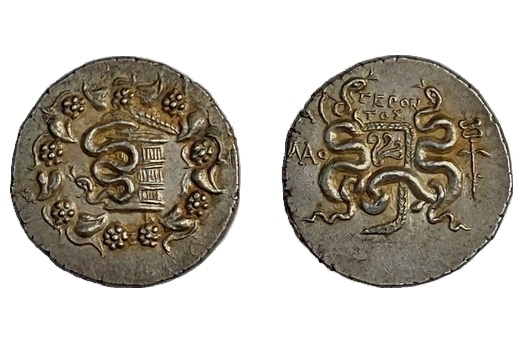
about ancient nomos
Ancient Nomos Art is a museum of galleries exhibiting ancient coins and ancient mint maps. The coin gallery displays the diverse art and history of hand-crafted ancient Greek, Roman, Byzantine, Persian and Medieval coinage. The ancient mints mapping gallery features Greek, Roman, Byzantine, Asia Minor and Medieval mint city regions and territories. Visitor's are welcome to explore, study and enjoy Ancient Nomos Art.

Greek, Phrygia – 88 BC
Laodikeia ad Lycum
From Ancient Galleries

Obverse: Cista mystica from which snake coils intertwining around the basket; ivy wreath with fruits surround.
Reverse: Two snakes coiled around a bow case; to left, ΛAO; above, ΓΕΡΟΝ/ΤΟΣ; in field to upper left, A; to right, winged kerykeion.
LEGEND SYMBOLS
Obv: Cista mystica from which snake coils; around, ivy wreath with fruits. Rev: Two snakes coiled around a bow case; to left, ΛAO; above, ΓΕΡΟΝ/ΤΟΣ; in field to upper left, A; to right, winged kerykeion.
The ancient city of Laodicea, Phrygia, was founded on the site of the older town by Antiochus II Theos, king of the Seleucid Empire, in 261-253 BC. Antiochus named the city in honour of his wife Laodice. In 220 BC, Achaeus declared himself king of the Phrygia region, but was later defeated by Antiochus the Great in 213 BC. Antiochus transported 2,000 Jewish families to Phrygia from Babylonia. These Jews were to serve as military settlers in support of the Seleucid monarchy, as the inhabitants of Phrygia had risen in revolt. Favorable terms were granted the Jewish settlers. They were permitted to live in accordance with their own laws, and each was allotted land on which to build and cultivate. Generous exemptions from taxes were also granted. Historians consider these events as ample testimony to the friendship of Antiochus toward the Jews. After the Battle of Magnesia in 188 BC when the Romans defeated the Seleucids, the Treaty of Apamea was signed which gave control of the whole of western Asia Minor to the Kingdom of Pergamon. With the death of its last king, its territory was bequested to Rome in 133 BC and the city received the title of free city. It suffered greatly during the Mithridatic Wars but quickly recovered under the dominion of Rome. Towards the end of the Roman Republic and under the first emperors, Laodicea benefitted from its advantageous position on a trade route and became one of the most important and flourishing commercial cities of Asia Minor, in which large money transactions and an extensive trade in black wool. During the Roman period Laodicea was the chief city of a Roman conventus, which comprised 24 cities besides itself; Cicero records holding assizes there ca. 50 BC. Strabo (64 BC – 24 AD) attributes the celebrity of the city to the fertility of the soil and the wealth of some of its inhabitants, amongst whom may have been Hiero of Laodicea, who adorned the city with many beautiful buildings and bequeathed to it more than 2000 talents at his death. The wealth of its inhabitants engendered a taste for the arts of the Greeks, as is manifest from its ruins, and that it contributed to the advancement of science and literature is attested by the names of the sceptics Antiochus and Theiodas, the successors of Aenesidemus (1st century BC) and by the existence of a great medical school. The cistophorus above depicts an open Cista with a mythic snake seen exiting its basket. The Cista is decorated with a center meander pattern and beads along the top and bottom. An ivy wreath, with alternating images of fruit, surrounds the Cista and snake. The coins reverse shows two large snakes and two smaller snakes intricately entwined around a bow-case. To the right of the snakes is the sacred Thyrsus of Dionysus. The Greek Thyrsus is a long symbolic pole featuring an entwined snake, topped with an arrangement of vines, ivy, and berries in a cone-like shape. The Thyrsus later developed into the staff carried by Asklepios and was known as a symbol of medicinal healing during the Roman Empire.
DOCUMENTATION
Value: Tetradrachm, in the Cistophoric weight standard. Metal: AR Silver. Weight: 12.53 grams. Mint: Laodikeia ad Lycum, Phrygia. Magistrate Gerontos. Date: circa 88-67 BC.
Attribution: NC 1995, p. 326, 34. Pinder -. SNG Copenhagen -. SNG von Aulock -; BMC -, Leu Numismatik AG 13, 141 (this coin).
Legend, Documentation and Attribution
